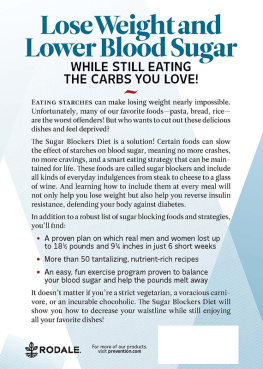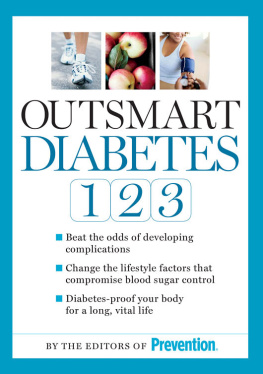Prevention Magazine - Undoing Diabetes Without Coming Undone
Here you can read online Prevention Magazine - Undoing Diabetes Without Coming Undone full text of the book (entire story) in english for free. Download pdf and epub, get meaning, cover and reviews about this ebook. year: 2011, publisher: Rodale, genre: Home and family. Description of the work, (preface) as well as reviews are available. Best literature library LitArk.com created for fans of good reading and offers a wide selection of genres:
Romance novel
Science fiction
Adventure
Detective
Science
History
Home and family
Prose
Art
Politics
Computer
Non-fiction
Religion
Business
Children
Humor
Choose a favorite category and find really read worthwhile books. Enjoy immersion in the world of imagination, feel the emotions of the characters or learn something new for yourself, make an fascinating discovery.

- Book:Undoing Diabetes Without Coming Undone
- Author:
- Publisher:Rodale
- Genre:
- Year:2011
- Rating:3 / 5
- Favourites:Add to favourites
- Your mark:
- 60
- 1
- 2
- 3
- 4
- 5
Undoing Diabetes Without Coming Undone: summary, description and annotation
We offer to read an annotation, description, summary or preface (depends on what the author of the book "Undoing Diabetes Without Coming Undone" wrote himself). If you haven't found the necessary information about the book — write in the comments, we will try to find it.
Undoing Diabetes Without Coming Undone — read online for free the complete book (whole text) full work
Below is the text of the book, divided by pages. System saving the place of the last page read, allows you to conveniently read the book "Undoing Diabetes Without Coming Undone" online for free, without having to search again every time where you left off. Put a bookmark, and you can go to the page where you finished reading at any time.
Font size:
Interval:
Bookmark:

without
Coming Undone
Its not easy to hear that you or someone you love has diabetes. While the condition is much-talked-about these days (most health experts consider it an epidemic in America), its different when the diagnosis hits home. It becomes personal. If diabetes has entered your life (even if youve just been told that you are at risk for diabetes, or have metabolic syndrome or prediabetes), you might have a lot of questionsfrom understanding exactly what diabetes is, to learning how to keep it in check on a day-to-day basis.
This guide was created to answer your questions. The culmination of hundreds of hours of interviewing experts and scouring scientific literature, it has a singular objective: to empower you not just to live with the disease, but to live beyond it. You will learn to manage it effectively so that it has the least possible impact on your long-term health and quality of life.
Diabetes isnt curable at least, not yet. But as we learned from doctors, nurses, nutritionists, exercise physiologists, certified diabetes educators (CDEs), and other professionals who specialize in diabetes care, the disease is treatable and controllable. In the case of type 2, by far the most common form of diabetes (and our primary focus here), this usually means lifestyle changes, possibly in combination with medicationthough its worth noting that maintaining a healthy lifestyle can delay and even eliminate the need for drug therapy.
Maintaining a healthy lifestyle takes effort. Even the most vigilant among us will have moments when our self-care gets a little lax. The trouble is, high blood sugar can start doing damagethe kind that leads to diabetes complicationslong before diabetes is even diagnosed. The good news is, the opposite is also true: You can lower your risk of complications by stabilizing your blood sugar at a healthy level. So were here to help give the nuts-and-bolts advice about nutrition, exercise, weight loss, sleep, stress reduction, and the myriad other factors that influence your blood sugar, along with an ample dose of encouragement and reassurance to help you stay on track.
Most public health experts mention epidemic in conjunction with diabetes. A sampling of the statistics gives us a sense of the scope and depth of the diabetes debacle:
- Currently, more than 25.8 million American adults and children have diabetes. Thats about 8.3 percent of the US population.
- Between 1990 and 2000, the prevalence of diabetes in the United States jumped by nearly 50 percent, and its expected to continue to grow in astronomical numbers.
- Certain ethnic groups are more prone to diabetes than others. The disease is about twice as prevalent among non-Hispanic blacks and Mexican Americans as among non-Hispanic whites.
- A growing number of children and adolescents are being diagnosed with type 2 diabetes, which the medical community long believed affected only people who were middle-aged or older (hence its former name, adult-onset diabetes). From 20022005, 3,600 youth were newly diagnosed with type 2 diabetes annuallya trend commonly attributed to the growing rate of obesity among our younger generation.
- It is estimated that 79 million adults aged 20 and older have pre-diabetes, which means that their higher-than-normal blood sugar levels predict a strong likelihood of developing type 2 diabetesunless they lose weight and step up their physical activity.
- As of 2007, an estimated $174 billion of our nations total medical expenditures was in some way attributable to diabetes, including $116 billion for direct medical care.
- According to the International Diabetes Federation, some 246 million adults worldwide have diabetes.
So even though we know getting the diagnosis can be a lonely feeling, rest assured that youre not alone in facing this challenge.
Why are so many Americans becoming diabetic? Though the cause of type 1 diabetes remains something of a mystery, experts generally peg type 2 diabetes as a lifestyle disease brought on by too many pounds and too little physical activity. Obesity is a major risk factor for type 2 diabetes. The two have such a strong connection, in fact, that experts sometimes refer to them by a single term: diabesity.
Obesitylike diabetesis reaching epidemic proportions in the United States and throughout the world. And more often than not, its a consequence of our modern lifestyle. Think about it: Many of us spend our days sitting at desks or standing on assembly lines rather than plowing and planting fields. We eat burgers and fries from the drive-thru instead of fresh fruits and vegetables from the garden. We drive our cars to run errands rather than walking to the bank or the post office.
And not only does physical inactivity definitely increases the likelihood of weight gain, it is also an independent risk factor for type 2 diabetes. In other words, even if youre not overweight, if you dont exercise much, your chances of becoming diabetic are higher; its been estimated that as much as 24 percent of the incidence of type 2 diabetes may be attributable to sedentary lifestyle. Combine inactivity and obesity, and you have a real double whammy.
In addition to these two huge risk factors, stress, smoking, lack of sleep, and exposure to pesticides and other environmental factors can all contribute to diabetes.
Simply put, diabetes occurs when your body is unable to properly process the glucose it gets from food. Glucose is a simple sugar that provides the necessary energy for cells to carry out their basic tasks. When this fuel cant get into cells, which is what happens in diabetes, they dont function as they should. And what happens to all that glucose that isnt getting into cells, where it belongs? It stays in your bloodstream. The medical term for this is hyperglycemia. Having blood thats too rich in glucose is like having motor oil thats too thick for your cars engine: It mucks up the works. More precisely, it upsets the super-sensitive biochemical balances that enable the body to properly function, setting in motion a chain reaction of health problems, such as high cholesterol, high blood pressure, heart and kidney disease, and vision trouble. All of this begs the question: Why cant your body use glucose as it should? It has to do with insulin, a hormone produced by the pancreas, an organ that is about the size of your hand and sits behind your stomach. Insulin serves a very specific purpose: It facilitates the bodys use of glucose by escorting the sugar into cells. Cells wont let in just any substance; gaining entry requires a certain access code, which insulin has. Once it unlocks a cell, glucose can get inside.
At least, thats how its supposed to work. There are two ways in which the partnership between insulin and glucose can break down.
The fundamental issue with type 1 diabetes is that the pancreas loses its ability to produce insulin. This happens because the bodys immune system, for reasons not fully known, attacks the cells that produce insulincalled beta cellsand destroys them. People who develop type 1 diabetes realize rather quickly that something isnt quite right because the symptomslethargy or drowsiness, weight loss, excessive hunger and thirst, vision changes, labored breathing, and increased urinationtend to be sudden and severe. For the past 20 years, the number of people getting type 1 worldwide has been steadily increasing. About half of those who have type 1 diabetes are diagnosed during childhood or their early teens, which is why for many years it was known as juvenile diabetes. That name has fallen out of favor, though, because weve learned that about 10 percent of those who are diagnosed with diabetes in adulthood have type 1. Often these people are initially misdiagnosed with type 2 because thats what doctors are accustomed to looking for in adults.
Font size:
Interval:
Bookmark:
Similar books «Undoing Diabetes Without Coming Undone»
Look at similar books to Undoing Diabetes Without Coming Undone. We have selected literature similar in name and meaning in the hope of providing readers with more options to find new, interesting, not yet read works.
Discussion, reviews of the book Undoing Diabetes Without Coming Undone and just readers' own opinions. Leave your comments, write what you think about the work, its meaning or the main characters. Specify what exactly you liked and what you didn't like, and why you think so.







